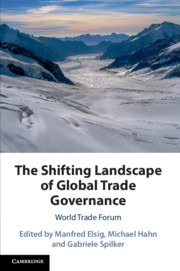Book contents
- The Shifting Landscape of Global Trade Governance
- The Shifting Landscape of Global Trade Governance
- Copyright page
- Contents
- Figures
- Tables
- Contributors
- Preface
- Abbreviations
- 1 Introduction
- Part I New and Old Challenges
- 2 The Elephant in the Negotiation Room
- 3 Corporate Strategy in Times of Anti-Trade Sentiment
- 4 Understanding and Shaping Trade Rules for the Digital Era
- 5 The Need for Better Disciplines on Rules of Origins in the WTO
- 6 For Whom the Bell Tolls
- Part II Trade Policy and Trade-Related Concerns
- Part III Development Angles
- Part IV Diffusion across Economic Treaties
- Index
- References
4 - Understanding and Shaping Trade Rules for the Digital Era
from Part I - New and Old Challenges
Published online by Cambridge University Press: 05 August 2019
- The Shifting Landscape of Global Trade Governance
- The Shifting Landscape of Global Trade Governance
- Copyright page
- Contents
- Figures
- Tables
- Contributors
- Preface
- Abbreviations
- 1 Introduction
- Part I New and Old Challenges
- 2 The Elephant in the Negotiation Room
- 3 Corporate Strategy in Times of Anti-Trade Sentiment
- 4 Understanding and Shaping Trade Rules for the Digital Era
- 5 The Need for Better Disciplines on Rules of Origins in the WTO
- 6 For Whom the Bell Tolls
- Part II Trade Policy and Trade-Related Concerns
- Part III Development Angles
- Part IV Diffusion across Economic Treaties
- Index
- References
Summary
The chapter provides an overview of the current and emerging trends in disruptive technologies and discusses the sweeping effects of digitization at different levels of the economy. The chapters focus then shifts to the effects of digitization on trade and explores the implications for trade policy. In order to understand what needs to be changed or at least calibrated in existing external trade policies, we need to know what we have in terms of existing regulatory frameworks – both at the international and at the regional and bilateral levels. It is the objective of the chapter’s third part to attend to this need as well as to show how selected countries have responded to the digital challenge and formulated distinct or less distinct responses in their respective external trade policies. Here, in particular, an understanding of the digital agenda of the United States, as well as of the new templates for electronic commerce, is essential and the chapter conveys this knowledge by focusing on the most advanced model so far - that of the Comprehensive and Progressive Agreement for Trans-Pacific Partnership (CPTPP). The chapter goes on to contextualize and assess the impact of the existing legal frameworks, as shaped by preferential trade agreements.
- Type
- Chapter
- Information
- The Shifting Landscape of Global Trade GovernanceWorld Trade Forum, pp. 73 - 106Publisher: Cambridge University PressPrint publication year: 2019
References
- 5
- Cited by



